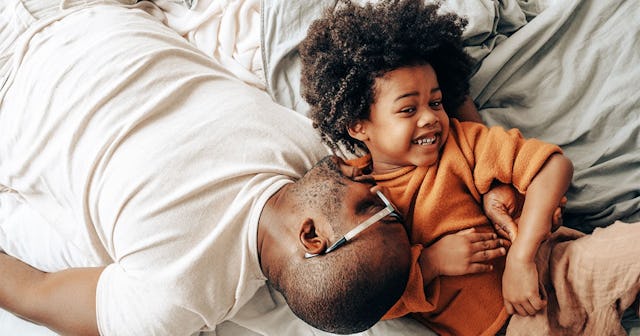Gender Nonconforming Kids––Who Are Supported At Home––Are Finding Relief In School Closures

Ideally, every kid would feel safe in every space they occupy. Realistically, too many kids don’t. If a child identifies as LGBTQIA+, whether out or not, and doesn’t conform to stereotypical gender codes, their level of safety varies based on the level of acceptance of the people surrounding them. Queer kids have every right to feel safe at home and school, but often one of those two places provides refuge from the other if, there is any refuge at all.
When schools across the country closed in March, some LGBTQIA+ kids lost supportive teachers, Gay-Straight Alliance clubs, and access to affirming friendships. In addition, some of these kids also gained full-time isolation with unsupportive parents and family members. This dangerous reality increases the risk of mental health issues and self-harming behaviors. However, there are parents and homes that are affirming, and for some queer kids the pandemic has provided relief from toxic school environments.
The LGBTQIA+ kids, particularly gender expansive youth, who are safe to be themselves at home, have noticed a decrease in anxiety and increase in confidence. When they aren’t constantly being told what they shouldn’t like or wear because of their gender, they can just be who they are without fear of bullying, snide comments, and the overwhelming pressure to change or fit in.
By the time kids are in preschool, they have developed gender stereotypes and biases. They equate colors, toys, clothes, and personality traits to either male or female identities. These biases have been learned and are perpetuated by books, movies, cartoons, music, games, and in all other aspects of our society. Kids feel the expectation to follow these rules about gender because they haven’t been told or shown often enough that there are so many other ways to be a human. Gender is fluid and so is gender expression, but until this is the “norm,” kids are going to fight their own desires and authenticity while also making fun of others for choosing to go against what is considered normal.
Fernanda Publio/Burst
According to the Human Rights Campaign 2018 LGBTQ Youth Report, only 26 percent of queer students say they always feel safe in their school classrooms; a mere five percent agree that their teachers and school staff are supportive of LGBTQ people. That leaves a lot of room for bullying, which happens at a disproportionately high rate for queer students. And when I say high rate, I mean 9 out of 10 LGBTQ kids report being bullied and harassed within a year.
The pandemic provided a break from this for many students. Yarrow Halpern at Gender Spectrum says, “It’s almost a vacation from bullying, a vacation from being bombarded with having to be ‘other’ all the time.”
Suz Sille is a psychotherapist and works with three transgender kids, ages 14, 15, and 17. Sille tells Scary Mommy, “All three [have had] amazing emotional growth and self-assuredness since schools closed. One is opting for home schooling, no matter what, next year. Parents are fully supportive. Yay! I just adore these kids.”
And Candace, mom to a six-year-old transgender son, tells Scary Mommy that her child has “blossomed since school has been out.”
I have witnessed this firsthand in my own transgender child, and she wasn’t in a toxic school environment. Yes, there is work to be done, but even in her affirming classroom and after-school program, my daughter experienced worry and discomfort around being outed or made an example of to explain what it means to be transgender. Not going to school eliminated that fear. My transgender kiddo is pretty confident in herself, but she was also relieved when she found she wasn’t going to summer camp this year. Day camp was an extra source of anxiety because she was around too many people she didn’t know, and she was afraid to be put into a position of having to explain or defend herself. Like many transgender people, she struggles with body dysphoria and swimming and changing in public is stressful.
Ketut Subiyanto/Pexels
I am nonbinary, and before I had top surgery, putting on a bathing suit was exhausting and traumatizing. Bringing attention to body parts I hated was like a slow death. While swimming is better now, people get my pronouns wrong and make assumptions about my gender based on how I look. It shouldn’t take a pandemic and being isolated from people to not be misgendered or feel dysphoric, but the unfortunate truth is that I have also felt better in my own body and gender expression since being around fewer people. This is a direct result of two things: I am not comparing myself as much to others in order to determine my gender’s validity, and others are not holding me up against a mirror of gender stereotypes. I have been able to feel more connected to myself without the influence of what people tell me gender should look like.
Schools are a breeding ground for this scrutiny. Wild how a deadly virus can make some kids feel better about themselves, huh? This is added proof that schools, particularly elementary schools, need to do a much better job of tearing down gender stereotypes while incorporating LGBTQIA+ diversity into books, lessons, and all aspects of the classroom. It’s also glaring proof that parents and caregivers need to do a better job at home before their kid gets to school and acts like an ass because they have been taught to stigmatize LGBTQIA+ people and topics.
Avoiding a subject means adding shame and negative connotations to it. Diversify your home library, and don’t be afraid of the uncomfortable conversations. Tolerance is not enough. Actively work to reprogram the way you and your family understand gender and gender expression. This will reduce internalized humiliation and external bullying.
Kids shouldn’t have to wait for a worldwide crisis to finally feel like they can relax.
This article was originally published on